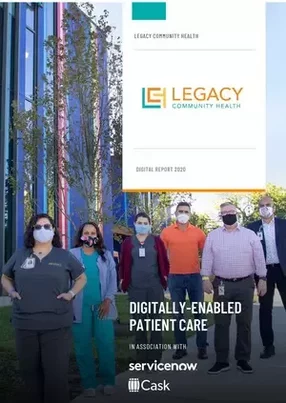Legacy Community Health: digitally enabling patient care
2020 has been a year of unprecedented challenges to healthcare providers across the globe. The COVID-19 pandemic has affected more than 38 million people around the world, with more than 7.8 million cases in the US alone. As US healthcare companies strive to cope with the monumental task of providing care during this crisis, as well as continue to support existing patients, many are turning to technology in order to digitally transform their operations. The new capabilities offered by Industry 4.0 are allowing for generational advances in the fields of telemedicine and remote care, as well as providing powerful new organizational capabilities that are revolutionizing the relationship between healthcare providers and their patients.
“This year has been really challenging. We had a lot of projects on our plate coming into the COVID-19 crisis in March, and then the crisis demanded we quickly shift priorities to remote patient care and working from home,” says Robert Tennant, Chief Information Officer (CIO) at Legacy, a full-service network of community health clinics offering primary and specialty care in the Texas Gulf Coast region. Tennant, who joined Legacy in August of 2019, has been at the forefront of the organization’s efforts to adapt, react and overcome the challenges, both of a global pandemic and of delivering quality healthcare to the underserved patients it serves throughout the Gulf Coast region. We sat down with him to learn more about harnessing digital transformation to support Legacy’s operations, and how to create a customer service-facing culture during the COVID-19 crisis and beyond.
When the COVID-19 crisis hit the United States in March of this year, Legacy, like many other providers in the industry, was almost entirely focused on in-person medical care. “Our first concern was figuring out how we were going to continue to deliver the care that patients need,” Tennant explains. “It was obvious that the first thing we needed to roll out was a telehealth solution, which we did in record time. We signed a contract with a vendor on a Friday and were treating patients remotely the following Wednesday.”
Tennant adds that he’s particularly proud of the speed with which Legacy transitioned to providing telehealth services to a patient base suddenly thrown into lockdown. “We went from just a few telehealth visits to about 3,000 per week in the span of three weeks. It was an incredible effort by my team and other teams throughout Legacy. The crisis gave us focus and we accomplished a lot in a very short amount of time.”
In tandem with a customer base that was suddenly unable to visit Legacy’s clinics and sites, the organization also had to adapt to its own staff’s transition to a remote working model. “It was kind of the perfect storm,” he recalls. “We made a big push towards working from home which was something we had not done before. Again, within just a few weeks, we managed to make a 180-degree shift to enable a significant number of people to work from home and, in the case of many of our providers, to provide care remotely.”
Today, Legacy’s Behavioral Health Service Line is delivering 91% more telehealth appointments than pre-COVID-19. “Virtual visits have drastically changed the way members of our community receive health care. Whereas virtual visits were previously reserved for those with private insurance that approved this option, now anyone can get the care they need from the comfort of their home,” commented Katy Caldwell, Legacy’s CEO, in May. Near the beginning of lockdown, Legacy also opened a virtual pediatric clinic to deliver care to minors in need of physical and/or mental health services.
In order to connect Legacy’s customers with its healthcare professionals, Tennant and his team have increased their efforts to digitally enable the organization’s customer-facing experience.
“A lot of our innovations are customer-facing. We’re working to build out what I call a digital patient engagement strategy - or a digital front door - for our patients, so they can take advantage of services from Legacy without having to come into a clinic or site,” Tennant explains. “Its development has only been accelerated by the COVID-19 outbreak. We want patients to be anywhere and be able to pick up their mobile device and self-schedule an appointment with us, arrange a telehealth visit, pay a bill, digitally sign a document, etc. We’re working diligently to digitally enable our patient engagement offerings.”
Internally, Tennant has also been working to increasingly automate and integrate the organization's back-end systems. “We’re looking at how to create a similar digital strategy to better serve our employees,” he explains, adding that their ongoing project is dedicated to alleviating the burden of manual processes from Legacy’s caregivers and support staff. Both internally and externally, Tennant and the Legacy team are engaging with technological innovation in the healthcare sector and beyond, in order to better harness the Industry 4.0 developments in service of their unique healthcare model.
“We’re not a hospital or a healthcare system; we’re a community health provider. We serve the underserved and we function very differently than a lot of other organizations in our industry. Culturally, I think we’re very unique and extraordinary in a lot of ways,” says Tennant. “We do look at what other people are doing, but we’re very entrepreneurial and agile as an organization. We do a lot of self-inquiry as a business and ask ourselves what we, our customers and our patients need, and how best we can serve those needs with technology.”
Both during and beyond the pandemic, Tennant notes that his number-one initiative is the creation of a culture of customer service. “I want my team to feel like their work is meaningful. I want them to feel safe. I want them to feel like they can make suggestions and be confident that they’ll be heard. And I want them to be able to go home at the end of the day and separate themselves from work. I want these things for everybody, including myself,” he says, stressing that, “If we don’t get the customer service element right, it’s going to undermine every other aspect of the culture that we’re trying to create.”


